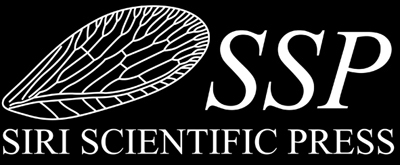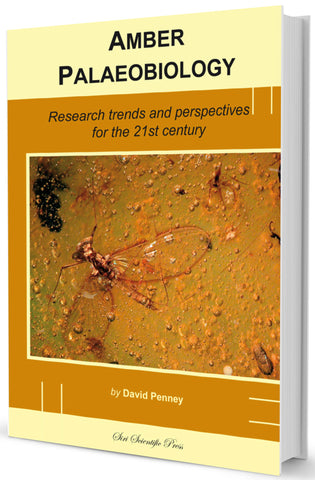New book review: Amber Palaeobiology
Posted by David Penney on
We are pleased to announce a nice short book review of our recent title Amber Palaeobiology, by David Penney, published in Entomologie heute (November, 2016) and Acta Biologica Benrodis (December 2016): “… the author, a renowned zoologist, arachnologist and authority on amber fossils, gives an overview on recent advances and developments in amber palaeobiology. Further, he develops ideas on future amber research and what might be very promising. He deals with old and new amber deposits, the latter for instance in China (“Palaeodiversity & New Amber Deposits”), with “Microbes in Amber” and then he focuses on “New Imaging Techniques”, ranging from photomicroscopy, confocal laser scanning microscopy, computed tomography, and synchrotron imaging (illustrated with impressive examples that provide evidence of the efficiency of the implemented technology), touches problems of “Palaeotaxonomy”, discusses “Palaeoecology”, “Palaeo/Biogeography“ and finally “Subfossils in Copal”. The booklet ends with a rather extensive reference list. In brief, this is a very nice and informative source.”
click cover to go to product page for more info or to order a copy
From the back cover
Fossils in amber provide a unique insight into the evolutionary history of arthropods (insects, spiders and their relatives), the most diverse and ecologically important group of animals on the planet today. The fossils provide direct evidence of many groups familiar to us now, living alongside extinct forms such as the dinosaurs. Furthermore, the fossils occur in staggering numbers and are represented by an exceptionally high diversity of extinct species. There can be little doubt that we are in a new technological era of research and with new deposits being discovered often there is a constant wealth of new material to work on and new ways in which we can do it. There are many general books on amber, but none of them has focused on what we can actually do with the palaeontological data provided by these remarkable fossils. What can they tell us and how should we utilize them in order to extract the most reliable conclusions about the palaeoecology of the past ecosystems in which the organisms once lived? In this book, Dr David Penney, a world recognised authority on amber fossils, considers these issues based on his two decades of research experience at the cutting edge of amber palaeobiological studies. It should appeal to the general amber enthusiast in providing an appreciation of recent discoveries and also some of the difficulties involved in the study of amber fossils, in addition to upcoming and established amber researchers, in the hope that it may help promote new, more focused palaeobiological studies using amber derived data.
Preface and introduction
Amber, fossilised tree resin, and its inclusions have been a popular source of intrigue for scientists since the times of Thales in ancient Greece (sixth century BC). However, physical evidence of human associations with amber (from caves in the Czech Republic) date back 40,000 years to the Middle Palaeolithic (Clark, 2010). In 1993, the blockbuster movie Jurassic Park highlighted the existence of fossil insects in amber to the general public and there can be little doubt that this movie formed the impetus for a greater interest (including increased scientific funding in the form or research grants) in this semi-precious material, which often contains fossil arthropods preserved with apparent life-like fidelity.
Indeed, the book you are reading now would not have been written had Jurassic Park not been produced when it was because the author’s PhD on amber was funded in 1994, just one year following its release (coincidence?). Similarly, other research projects were funded elsewhere (e.g. Europe and Lebanon) resulting in a new body of young and enthusiastic amber scientists (now with their own students) to take this research field into the 21st century. Several conferences have been dedicated to the study of fossil insects, arthropods and amber, mostly under the auspices of the International Palaeoentomological Society (IPS), which was formed at the second of these meetings: Moscow, Russia (1988); Kraków, Poland (2001); Pretoria, South Africa (2005); Àlava, Spain (2007); Beijing, China (2010); Byblos, Lebanon (2013); Edinburgh, UK (2016). The IPS is still in the stages of metamorphosis, but the successful nature of the meetings to date looks set to continue into the future.
Several popular books on amber followed in the wake of Jurassic Park, and they provide a wealth of background information on the history of amber, its physical and chemical properties and the scientific study of its fossilized inclusions. The book you are settling in to read now is focused more on the future of amber research and assumes a certain level of familiarity with the subject matter. Hence, very general background information available via a multitude of other sources is not repeated here.
The very recent discoveries of new deposits, representing the first major fossiliferous amber finds for some countries previously unaccustomed to researching fossils preserved in this medium (e.g. Amazonia, India, Australia, New Zealand, Ethiopia), will no doubt result in the establishment of new research groups in the near future. However, so far, there does appear to have been a trend for research on these new deposits by established overseas research groups (just look at the authorship on new papers concerning these deposits). This is not the case for the Australian amber, although only one species has been described from this source to date.
Throughout history various inventions have had a profound global impact on the way in which we live our lives and conduct our daily business, including how we do research. Which of these human achievements can be considered the most important is often debated, but there can be no doubt that increased computing capabilities and the internet rank towards the top of the list. The internet has been around for only a couple of decades and even at the turn of the 21st century many of us were still submitting our research papers in quadruple hard copy format by regular mail. Also, towards the end of the 20th century, museum loans and various other forms of correspondence were also often still done without the benefit of electronic mail. As for the research itself, literature searches and acquiring the relevant papers were considerably more laborious and time consuming than they are at present.
With the click of a single button, we can now correspond almost instantaneously with multiple colleagues on all continents at the same time. We can share vast quantities of data and collaborate with other researchers more easily than ever before, but it is not only the internet that has facilitated our research. Increased computing capabilities have resulted in more sophisticated methods of analysing large, complicated datasets and more advanced modelling systems. Advances in molecular techniques and imaging technologies are also playing a huge role in 21st century research. The result is a great increase in high quality, multi-disciplinary research output being published in an ever-increasing number of diverse, rapid-publication journals, to the extent that it is difficult to keep track of all the progress that has been made in recent years and in which directions the various fields are heading.
There can be little doubt that we are in a totally new era of research. Close your eyes for a moment and transport yourself back in time to the early to mid-1800s. It is easy to imagine Georg Karl Berendt, the German physician, palaeontologist and one of the pioneers of amber inclusion taxonomic research, studying his Baltic amber specimens with only a basic microscope. Even in his wildest dreams, Berendt could never have envisaged how the study of amber inclusions would be revolutionised in little more than a century and a half. The same can also be considered true of Alexander Petrunkevitch who worked on fossil spiders in amber during the early to mid-1900s, i.e. a century after the earlier work of Berendt. One must wonder how technological progress will alter the face of research a century and a half from now and whether we are also currently working away with the same degree of blissful ignorance of what the future may realistically hold. Such new discoveries and technological advances have maintained a steady stream of press releases relating to amber and have kept these fossils in the public eye. Scientists and the general public are as fascinated with amber fossils now as they ever have been. The creation and success of new museum exhibitions dedicated to amber (e.g. Ross & Sheridan, 2013) is clear evidence of this.
In this volume, which initially evolved from me being invited to give a keynote lecture on amber research at a palaeontology conference in Germany (2013), I aim to bring together the major advances in amber ‘palaeobiology’ research (i.e. excluding geochemistry, physical properties, etc.) over the last few years and also to propose various directions in which I feel more focus is needed in the future. Some workers may disagree with what I prioritise, but such is the nature of science and scientists. In order to be succinct, on the whole I have drawn from my own research, supplemented by work from additional authors where necessary in order to cover the vast and diverse range of scientific disciplines encompassed by amber palaeobiological research and I beg your understanding of my self indulgence in this regard.
In summary, this book represents the thoughts of an active researcher currently engaged in various different aspects of amber palaeobiology, including the application of new cutting edge technologies such as computed tomography scanning and next generation DNA sequencing. It is aimed at the general amber enthusiast, such that it may give them an appreciation of recent discoveries and also some of the difficulties involved in studying amber fossils, in addition to upcoming and established scientists in the hope that it may help promote new, more focused quantitative palaeobiological studies based on amber derived data. I also hope this book will encourage more neontologists to engage in collaborative studies with palaeoentomologists or at least to consider the fossil record in their studies. After all, even if one has data on 99% of the extant taxa for a particular group, one may still be missing 99% of the total data available, whether it be in the form of taxonomic characters or (palaeo)geographic distribution data, for which the fossil record can provide ample evidence.
This book probably raises more questions than it answers. Indeed, if we had all the answers, or if such answers were easy to obtain, then it would be a very boring field to research. If just a single PhD thesis is published as a result of an idea inspired by this short work (which in reality reflects two decades of thought) then this book will have served its purpose.
David Penney, February 2016
Contents
Palaeodiversity & New Amber Deposits
Newly discovered deposits
Important current research themes (previously known deposits)
The better studied deposits (Burmese, Baltic & Dominican ambers)
Canadian amber
Mexican amber
Fushun amber
Microbes in Amber
New Imaging Techniques
Photomicroscopy
Confocal laser scanning microscopy
Computed tomography
Synchrotron scanning
Computer-generated imagery (CGI animation)
Palaeotaxonomy
Palaeoecology
Quantifying the representative sample
Low taxonomic resolution palaeoecology
High taxonomic resolution palaeoecology
Syninclusions
Combining amber & non-amber fossil data
Concluding thoughts on quantitative palaeoecology
Palaeo/Biogeography
Subfossils in Copal
A proxy for understanding taxonomic bias in amber
DNA
Conclusions
Literature Cited
Share this post
- 0 comment
- Tags: Book review, News
0 comment

